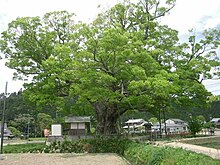Japanese zelkova
| Zelkova serrata | |
|---|---|
 |
|
| "Noma Keyaki", a 1,000-year-old keyaki in Nose near Osaka in Japan, 25 m tall, 11.95 m trunk circumference; second-largest known specimen. | |
| Scientific classification | |
| Kingdom: | Plantae |
| (unranked): | Angiosperms |
| (unranked): | Eudicots |
| (unranked): | Rosids |
| Order: | Rosales |
| Family: | Ulmaceae |
| Genus: | Zelkova |
| Species: | Z. serrata |
| Binomial name | |
|
Zelkova serrata (Thunb.) Makino |
|
Zelkova serrata (Japanese zelkova, Japanese elm or keyaki; Japanese: 欅 (ケヤキ) keyaki /槻 (ツキ) tsuki; Chinese: 榉树/櫸樹 jǔshù; Korean: 느티나무 neutinamu) is a species of the genus Zelkova native to Japan, Korea, eastern China and Taiwan. It is often grown as an ornamental tree, and used in bonsai. There are two varieties, Zelkova serrata var. serrata in Japan and mainland eastern Asia, and Zelkova serrata var. tarokoensis (Hayata) Li on Taiwan why differs from the type in its smaller leaves with less deeply cut serration on the margins.
Zelkova serrata is a medium-sized deciduous tree usually growing to 30 m (98 ft) tall. It is characterized by a short trunk dividing into many upright and erect spreading stems forming a broad, round-topped head. The tree grows rapidly when young though the growth rate slows to medium upon middle age and maturity.
It has alternately arranged leaves growing to 5 cm long and broad. The leaves themselves are simple and ovate to oblong-ovate with serrated or crenate margins, to which the tree owes its specific epithet serrata. The leaves are acuminate or apiculate, rounded or subcordate at the base, and contain 8-14 pairs of veins. The leaves are rough on top and glabrous or nearly glabrous on the underside. They are green to dark green in spring and throughout the summer, changing to yellows, oranges and reds in autumn. The petioles are 2–5 mm (1⁄16–3⁄16 in) long.
...
Wikipedia
